The genus Duchesnea, which shows a wide range of variation in morphology, as pointed out by Hooker (1878), is an indigenous plant distributed in the Old World from Afghanistan to Japan, and now naturalized in Europe, Africa and the New World. Many floristic works have been prepared for the Indo-Himalayan region (Don, 1825; Hooker, 1878; Kitamura, 1955; Hara & Kurosawa, 1963; Hara, 1966; Murata, 1974; Hara & Williams, 1979; Malla et a/., 1976 & 1986), but most only describe the collecting localities or report some characteristics of the plants. In Nepal, only D. indica has been reported for this genus, but in Japan, many taxa have been described in Duchesnea, which Hara and Kurosawa (1959) combined into two species, D. chrysantha (diploid) and D. indica (dodecaploid) and one hybrid (heptaploid). Naruhashi et al. (1986) described another hybrid with a different polyploid level (octoploid). Kalkman (1968), however, claimed that D. indica should include D. chrysantha on the basis of investigations of the Malesian plants. It is obvious that more information is necessary for clarifying the infrageneric taxonomy of this genus.
For several years, we have been working on the taxonomy of Japanese Duchesnea and have found that the presence or absence of nectar guides on the petals and chromosome numbers are of great importance in the recognition of species (Naruhashi, unpublished). Fortunately the senior author, as a member of the Nepal-Japan Botanical Expedition to Nepal had a chance to research the Nepalese D. indica. Duchesnea indica growing in the fields showed such wide morphological variation that different chromosome numbers from those already known were suspected. In the present paper we examine the morphology of the flowers, including the nectar guides of the petals, and the chromosome numbers of the Nepalese D. indica and compare the results with those from Japanene plants.
Habitat
In the Indo-Himalayan region, the distribution of D. indica ranges from 500 m (Hara, 1966) to 3,200 m in altitude (Kitamura, 1955). To our experience, this species seems to grow commonly between 1,300 m and 2,500 m in altitude. In Nepal, D. indica grows in open to partially shaded areas, such as in open grasslands, roadsides, cultivated grounds, or open spaces by houses. In Japan the two species of Duchesnea, D. chrysantha and D. indica, each prefers a different habitat, that is, D. chrysantha usually grows in open sunny places and D. indica grows in shaded places. Thus, the Nepalese D. indica occupies the habitats of both Japanese species.
The population sizes of the Nepalese D. indica are smaller than those of the Japanese plants, which sometimes forms large mats.
Morphology of Flowers
Hara and Kurosawa (1963) pointed out that the plants, especially the leaves, of the Nepalese D. indica growing in some localities are smaller than in Japan. When the Nepalese and Japanese D. indica are cultivated together in Toyama, Japan for comparison, the Nepalese plants are smaller than the Japanese plants and their leaves are thinner, yellowish green with a round terminal leaflets. The Japanese plants have thicker dark green leaves and rhomboid terminal leaflets.
The flowers of the Nepalese D. indica are also smaller than those of the Japanese plants both in nature in Nepal and in the experimental fields in Toyama (Plate 1a, Fig. 1). In the Nepalese D. indica, cultivated in Toyama, the length of the petals ranged from 6.1 mm to 7.3 mm, and their width ranged from 4.1 mm to 5.4 mm (Fig. 1, spots in dotted circle). The sampling localities of the Nepalese D. indica are shown in Table 2. In the Japanese D. indica collected from four populations in Toyama, the length of the petals ranged from 7.6 mm to 11.5 mm, and their width ranged from 4.7 mm to 8.4 mm.
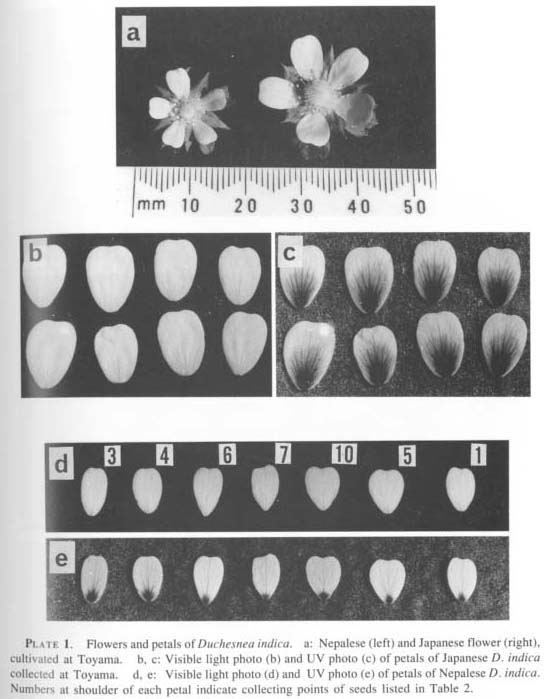
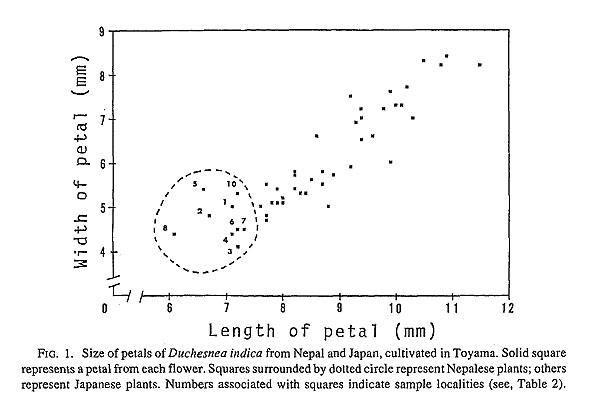
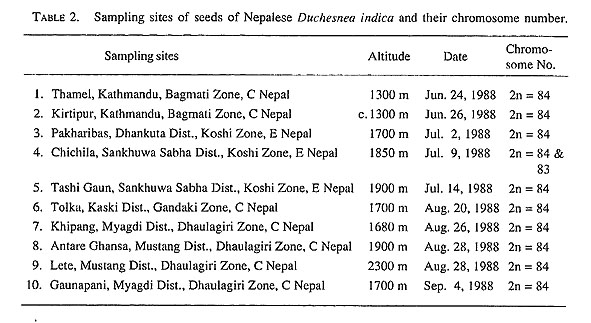
It is well known that floral components exibit a higher ultraviolet (UV) absorbancy than the leaves. In some plants, the basal part of the petal absorbes UV more strongly than the peripheral parts, and shows up with special equipment as a nectar guide.
The flowers of D. indica have a nectar guide, which can be detected only in photographs taken with a filter that prohibits the transmission of visible lights (UV photo). In Japanese Duchesnea, it is known that the size of the nectar guide varies according to species and polyploid level (Naruhashi, unpublished). By examining UV photos of flowers of Nepalese D. indica grown at five localities in Nepal (Table 1, Plate 2 & 3) and those cultivated in Toyama (Plate 1d & e). It became clear that the nectar guides of all Nepalese D. indica examined were smaller than those of the Japanese plants (Plate 1b, c, d, & e).
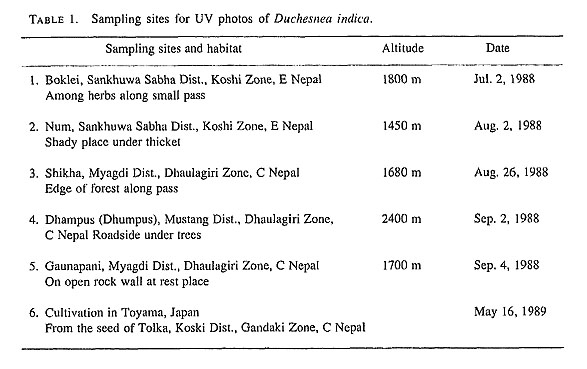
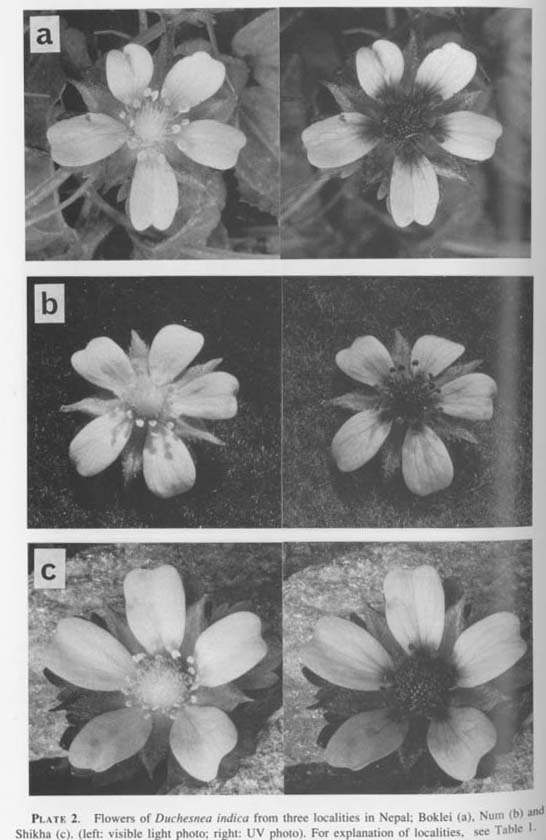

Cytology
In the genus Duchesnea polyploidy is known and a basic number of x = 7 (Fedorov, 1969), and a polyploid series of 2n = 14, 21, 28, 49, 56 and 84 has been reported by many workers (Ichijima, 1926; Hara & Kurosawa, 1959; Hsu, 1968; Naruhashi et al., 1986; Naruhashi & Takano, 1987). Hara and Kurosawa (1963) reported 2n = 84 in D. indica collected from Darjeeling and Sikkim, however, no report has been made to data on this species from Nepal.
For analysis of chromosome number, we used plants grown from seed. Ten samples of seeds were obtained from natural populations in Nepal (Table 2). Root tips were pretreated with 0.002M 8-hydroxyquinoline at 20 C for 1 hour and then kept at 4 C for 15 hours (Kuroki & Kurita, 1969). The materials were fixed in a solution of acetic acid : ethanol (1:3) for 20 minutes at about 20 C. The fixed root tips were macerated in 1 N HCl for 11.5 minutes at 60 C. Lactopropionic orcein was used for staining.
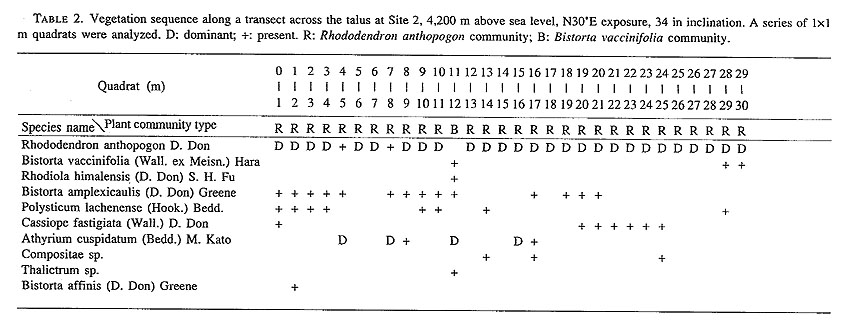
The examinations revealed that all samples were dodecaploid, having 2n = 84, with one exception where the chromosome number was 2n = 83 (Table 2 & Plate 4), which is a hypoploid plant, germinated from seed collected at Chichila. Although we have investigated the chromosomes of Duchesnea from more than 1800 Japanese natural populations, no hypoploid plants have been observed. This is the first report of a hypoploid plant in Duchesnea, indicating that hypoploidy is rare in this genus.
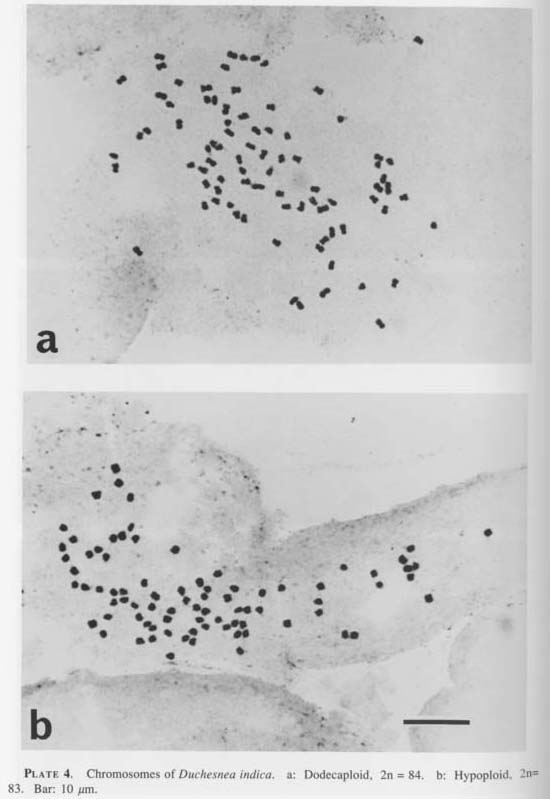
Conclusion
In Japanese Duchesnea, it is known that the size of a plant corresponds to species and hybrids of different polyploid levels. Naruhashi (unpublished) found that D. chrysantha (diploid) lacks nectar guides, while the two hybrids, whose sizes vary according to polyploid level, and D. indica possess them. The present investigation shows that the Nepalese D. indica has a consistent chromosome number (2n = 84) that coincides with previous reports (Ichijima, 1926; Hara & Kurosawa, 1959; Naruhashi et al., 1986), even though there is a wide range in habitats and smaller leaves, flowers and nectar guides in the Nepalese plants. This phenomenon is very interesting when one attempts to study the evolutionary process leading to dodecaploid from diploid plants and their geographical distribution.
Acknowledgement
It is a great pleasure to express our sincere gratitude to Dr. Mitsuo Suzuki and the other members of the Nepal-Japan Botanical Expedition, and Dr. Samar B. Malla in the Department of Forestry and Plant Research, H.M.G. Nepal. We are also greatly indebted to Drs. Shin Watanabe and David E. Boufford who kindly read and criticized the manuscription. This research was partly supported by the Ministry of Education, Science and Culture, Japan No. 62480014 to N. N.
References
- Don, D. 1825.
- Prodromus Florae Nepalensis, p. 233.
- Fedorov, A. A. 1969.
- Chromosome number of Flowering Plants, p. 621, Komar. Bot. Inst. Academy of Science, U.S.S.R., Leningrad.
- Hara, H. 1966.
- The Flora of Eastern Himalaya, p. 120.
- ——— and S. Kurosawa, 1959.
- On the Duchesnea indica group. Journ. Jap. Bot. 34: 161-166.
- ——— and S. Kurosawa. 1963.
- Cytotaxonomical studies on Japono-Himalayan elements (1). Journ. Jap. Bot. 38: 71-74.
- Hara, H. and L. H. J. Williams. 1979.
- An Enumeration of the Flowering Plants of Nepal, vol. 2, p. 136.
- Hooker, J. D. 1878.
- Flora of British India vol. 2, p. 343., L. Reeve, London.
- Hsu, C. 1968.
- Preliminary chromosome studies on the vascular plants of Taiwan (II). Taiwania 14: 11-27.
- Ichijima, K. 1926.
- Cytological and genetic studies on Fragaria. Genetics 11: 590-604.
- Kalkman, C. 1968.
- Potentilla, Duchesnea and Fragaria in Malesia (Rosaceae). Blumea 16 (2): 344-348.
- Kitamura, S. 1955.
- Flowering plants and ferns. In: Kihara, H.(ed.), Fauna and Flora of Nepal Himalaya 1: 148.
- Kuroki, Y. and M. Kurita. 1969.
- Karyotypes of Rumex acetosa L. Mem. Ehime Univ. Sci. Ser. B, 6: 41-49.
- Malla, S. B. et al. ed. 1976.
- Flora of Langtang and Cross Section Vegetation Survey. Bull. Dept. Med. Pl. Nepal No. 6, p. 86.
- Malla. S. B. et al. ed. 1986.
- Flora of Kathmandu Valley. Bull. Dept. Med. Pl. Nepal No. 11, p. 280.
- Murata, G. 1974.
- A list of plants collected by the Chiba University, Rolwaling Himal Expedition, 1963 2. Acta Phytotax. Geobot. 26: 77.
- Naruhashi, N., Itahashi, T. and Y. Iwatsubo. 1986.
- Chromosome numbers of Duchesnea in Toyama Prefecture, Japan. La Kromosomo 11-42: 1330-1335.
- ——— and H. Takano. 1987.
- Chromosome numbers and distribution of Duchesnea (Rosaceae) in Gifu Prefecture. Acta Phytotax. Geobot. 38: 155-160.







